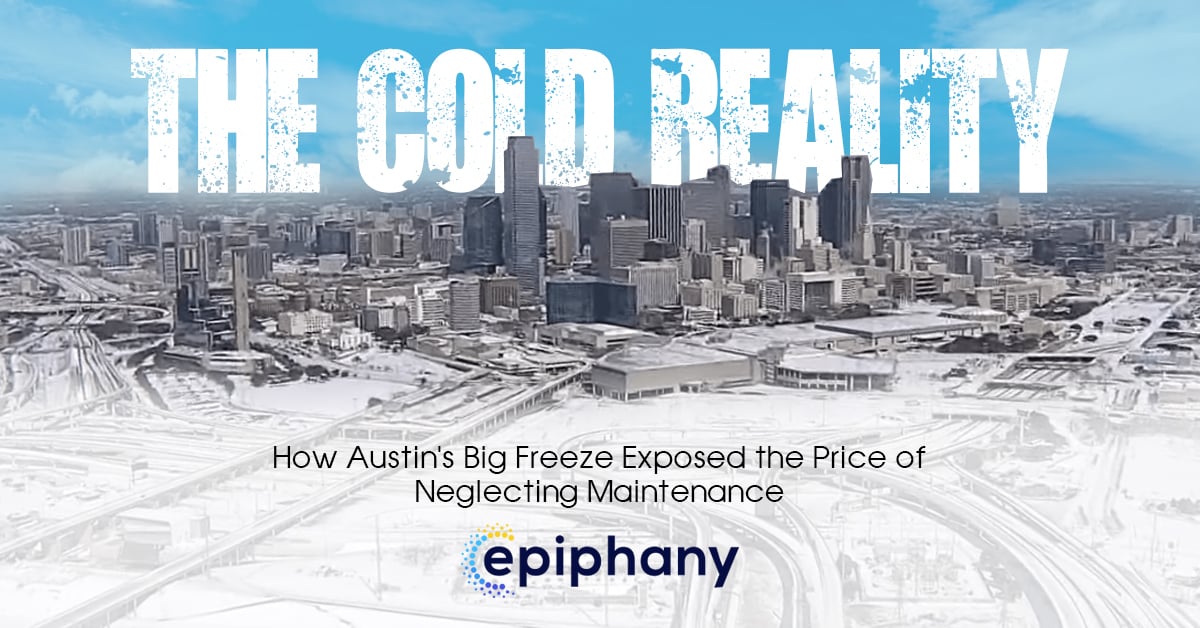Picture this: Austin, Texas, a city known for its warm vibes and sunny days, suddenly found itself in the icy grip of an unexpected deep freeze. It was a bone-chilling surprise that left residents huddling for warmth and searching for answers. But what truly sent shivers down our spines was the staggering number of lives lost during this unprecedented weather event. It was a wake-up call that couldn’t be ignored, prompting us to dig deeper into the heart of the matter.
As we embark on this journey, our central focus becomes unmistakable: It revolves around the stark repercussions of maintenance negligence, and how it served as a decisive factor in escalating a mere cold snap into a full-fledged crisis.
So, let’s unravel the story behind Austin’s big freeze and discover a few of the lessons it has to offer.
Windmill Saga – Bracing for the Freeze
For starters, let’s dive into the curious world of Austin’s windmills. You know, those towering giants that line our cityscape and promise to harness the power of the wind. They’ve got a reputation, you see, for being able to handle temperatures as low as 35 degrees – a bit chilly by our standards, but we’ve trusted in their abilities. So, as the frosty winds started to howl during the big freeze, we couldn’t help but wonder if these windmills would indeed keep their cool.
Did They Weather the Storm, or Did They Bail?
Fast forward to those icy days during the freeze – did the windmills live up to their cold-weather bravado? Well, it turns out that Mother Nature had a bone to pick with them. Some of those windmills, despite their rugged claims, decided it was a bit too nippy for their liking. They sputtered, they froze (ironic, right?), and in some cases, they just threw in the towel. So much for the “35-degree champs.” But what’s the big deal, you ask?
Now, here’s where it gets interesting. Those windmills weren’t just for show; they were a vital part of Austin’s energy equation. When they started freezing up, it sent shockwaves through our power grid. Imagine flipping the light switch, but nothing happens – your TV goes dark, your heater gives up, and the coffee maker goes on strike.
That’s the reality Austin faced during the freeze. Windmill failures meant less electricity, which, in turn, meant rolling blackouts and chilly nights for many residents. So, while we may have expected picturesque, spinning windmills, we got an unexpected lesson in the fragility of our energy supply during extreme weather.
Unpacking Austin’s Weather Time Capsule
Let’s take a little journey back in time, Austin-style. Our weather here can be as unpredictable as a cat on a hot tin roof. But what about those bone-chilling days when the temperature dips below the magical 10-degree mark? Has Austin ever cozied up to the deep freeze before?
Well, history tells us that Austin has, on occasion, flirted with colder temperatures below 10 degrees. It’s like finding a hidden treasure in the attic of weather data. Every so often, Mother Nature reminds us that she’s got a frosty side, and we get a taste of her icy surprises.
You might be thinking, “So what’s the big deal, right?” Well, hold onto your winter hats because there’s more to it. The significance lies in the patterns. When something that used to be a rare weather oddity becomes less rare, it’s like a weather alarm clock ringing in our heads, saying, “Wake up and smell the chilly air!”
The Austin Freeze was a wake-up call, not just because of its immediate impact, but because it hinted at a pattern that could become a recurring nightmare. It wasn’t merely a one-off hiccup in our weather; it was a piece of a much larger puzzle. When we look at the past few years, we’ve seen more frequent and intense cold spells in Austin. The question that looms large is whether these colder spells are becoming the new normal in our weather forecast.
Preparing for the Inevitable
If history is any indicator, another big freeze is not a matter of if but when. It’s not a pleasant thought, but it’s a reality we must face. So, what does this mean for our city’s readiness? It means that establishing solid maintenance habits now is not just a good idea; it’s a necessity. We can’t afford to treat extreme weather events as rare occurrences anymore. We must be proactive, not reactive.
Imagine if we had a well-maintained infrastructure, including windmills, heating systems, and pipes, in place before the freeze hit. We could have weathered the storm with fewer disruptions and saved lives in the process. This pattern of colder weather demands that we adapt and prepare for a future where such events are more frequent.
This means that the Austin Freeze was a stark reminder that we’re dealing with a changing climate, and we must adjust our maintenance practices accordingly. Another big freeze is on the horizon, and it’s our responsibility to establish robust maintenance habits now to protect our city and its residents when the next freeze inevitably comes knocking.
Austin’s Maintenance Mystery
Now let’s roll up our sleeves and dive into Austin’s maintenance practices – or the lack thereof. You see, when it comes to preventative maintenance (PM), Austin isn’t exactly leading the charge. PM is like giving your car regular check-ups to avoid a breakdown on a cross-country road trip. But here in Austin, we’ve been more of the “break-fix” persuasion.
We know that maintenance is like the unsung hero of a well-functioning city. It’s those behind-the-scenes actions that keep things running smoothly. Preventative maintenance (PM) is all about staying ahead of the curve. It’s like going for regular check-ups with your doctor to catch any health issues before they become major problems.
Unfortunately, Austin has often fallen short in this department. We’ve been a bit too “fix it when it breaks” rather than taking proactive steps to prevent issues from happening in the first place.
The Break-Fix Conundrum
So, what’s “break-fix”? Well, it’s exactly what it sounds like. Instead of preventing problems in the first place, we wait for things to break, and then we scramble to fix them.
While it might seem like a way to save time and money upfront, it often ends up costing more in the long run. Why? Because when things break, they tend to break in a big way, causing more damage and requiring more expensive fixes.
Plus, there’s the inconvenience factor – imagine your power going out in the dead of winter because a critical component wasn’t maintained properly. It’s like a cold wake-up call, quite literally.
Challenges When Crisis Strikes
Now, picture this: a big freeze like the one we had. Everything’s frozen solid, and suddenly, things start breaking. Pipes burst, windmills freeze, and all heck breaks loose. Here’s the kicker, trying to fix critical infrastructure during a crisis is like trying to change a tire in a blizzard. It’s messy, it’s chaotic, and it’s not exactly efficient.
Properly maintained infrastructure is like a safety net, ready to catch us when things go awry. In the case of the freeze, well-maintained heating systems could have kept homes warm, preventing hypothermia and illnesses. Regularly checked pipes would have been less likely to burst, sparing homes from water damage and dangerous icy conditions.
It’s not just about comfort; it’s about survival. Adequate maintenance can mean the difference between life and death during extreme weather events. When systems are well-maintained, they are more reliable and less likely to fail catastrophically.
The Life-and-Death Impact of Maintenance
During the unprecedented Austin Freeze, the life-and-death consequences of maintenance practices became glaringly evident. It was a chilling reminder that the maintenance of critical infrastructure isn’t just about keeping things running smoothly; it’s often a matter of life and death.
Facing the Grim Reality
This terrible freeze, which hit us like a freight train in 2001, sadly claimed the lives of 246 individuals. But those numbers? They’re not just cold statistics; they’re the heart-wrenching stories of real people. Families were torn apart, communities were left reeling, and dreams were shattered. These weren’t just numbers on a page; they were our neighbors, friends, and loved ones.
Stories That Hit Home
To really understand the impact, let’s zoom in on a couple of stories.
Let’s talk about Cristian Pavon Pineda, an 11-year-old, who tragically passed away in his sleep due to a power outage in his mobile home in Conroe, Texas.
Cristian’s mother, Marie Pineda, shared that he was a vibrant, healthy young boy. The relentless winter storm offered Cristian his first real experience with snow, and he was overjoyed.
“That’s why he was so excited outside,” Marie explained. “Everything was fine. He was full of happiness that day, and he wasn’t unwell at all.”
On that fateful night, Cristian shared his bed with his 3-year-old stepbrother. Their stepfather, Manuel, checked on them during the night, finding both children peacefully asleep. However, when morning came, Cristian remained unresponsive. “He was already gone,” Pineda painfully recalled.
An autopsy has been conducted, but local officials anticipate it will take several weeks to determine the exact cause of Cristian’s untimely passing. Hypothermia is suspected to be the leading factor. (Source: Washington Post)
And then there’s James, an elderly gent living solo. When his pipes burst like fireworks on the Fourth of July due to the freeze, he was stuck in a tough spot. His home flooded, and he took a nasty spill on the icy floor, fracturing his hip. No phone, no way to call for help, just pain and loneliness. (Source: Motherly)
These stories aren’t anomalies; they’re snapshots of the struggles many Austin residents faced during the freeze. It wasn’t just an inconvenience; it was a life-threatening situation brought about by the breakdown of critical infrastructure.
And at last, our very own Brenda Wanta, whose family was out of water and power for 10 days. “We would alternate going to the car to warm up versus huddling under blankets inside”, says Brenda.
And what was a part of the problem? Windmills! They were not kept in the highest working order. Why? because Texas does not freeze for more than a day or 2 in a row. And no one saw it coming.
The Price and Cost of Windmill Maintenance: A Critical Analysis
Let’s zoom in on a particularly crucial aspect of maintenance. These towering giants called windmills, owned by the city, had the potential to keep the lights on and homes warm. But their maintenance, or lack thereof, played a pivotal role in the disaster.
When it comes to windmill maintenance, the price and cost are at the forefront. The immediate price involves the dollars invested in regular check-ups, repairs, and upkeep. On the flip side, there’s the long-term cost – what happens when you skimp on maintenance or adopt the “break-fix” approach?
Coming Back to the “Break-Fix” Conundrum
Now, let’s dissect the cons of the “break-fix” approach for windmills. Think of it this way: a windmill breaks down during an extreme cold snap. It’s not just inefficient; it’s a catastrophe waiting to happen. Repairs become urgent, and you can’t always source the best materials or experts in the middle of a crisis. The result? Compromised quality and sky-high costs.
It’s like waiting for your car to break down in the middle of a cross-country road trip and hoping a roadside mechanic will have the perfect spare parts. Spoiler alert: It rarely works out that way.
The Pros of Preventative Maintenance: Saving Lives and Money
Now, let’s shift gears to the pros of preventative maintenance (PM) for windmills. Think of it as giving your windmill a regular health check. It might seem like an expense, but it’s an investment in reliability and, in this case, saving lives.
Regular maintenance ensures that windmills are in peak condition when you need them most. It’s like having a generator ready to kick in during a power outage – you’re prepared, and you avoid the chaos and costs of a breakdown.
During the Austin Freeze, well-maintained windmills could have been the difference between hundreds of homes having electricity and heat or facing darkness and bitter cold. So, when we talk about the price and cost of windmill maintenance, it’s not just dollars and cents; it’s about safeguarding lives and ensuring our city can weather the storm, quite literally.
How Epiphany Can Help
Epiphany’s MRO solutions could be a game-changer in maintaining windmills effectively. With our expertise in repair management, project profitability, and contract management, Epiphany offers a tailored approach to equipment management that aligns perfectly with the needs of windmill maintenance.
Our solutions can streamline the maintenance process, ensuring that critical components of windmills are regularly inspected and serviced, thus preventing costly breakdowns during extreme weather events like the Austin Freeze.
Our MRO consulting services can provide valuable insights and recommendations to enhance windmill maintenance practices, ultimately contributing to increased reliability and the seamless operation of these crucial energy sources.
Wrapping Up
As we wrap up this journey through the intricacies of maintenance practices, it’s clear that the lessons from the Austin Freeze run deep. We’ve explored the price and cost of maintenance, the cons of the “break-fix” approach, and the pros of preventative maintenance. We’ve witnessed the profound life-and-death impact of maintenance during that chilling event and how it could have made all the difference.
But it doesn’t stop here. The importance of proper maintenance, especially for critical infrastructure like windmills, cannot be overstated. It’s about investing today to save tomorrow, both in terms of money and, more importantly, lives. And that’s where Epiphany’s MRO solutions come into play, offering a well-tailored path to keeping our windmills spinning smoothly.
So, as we navigate the ever-changing weather patterns and challenges that lie ahead, let’s remember that maintenance isn’t just about fixing things; it’s about ensuring our safety, comfort, and resilience in the face of the unexpected. It’s a journey of learning and adapting, and we’re all in it together. Stay prepared, stay safe, and let’s keep those windmills turning!






